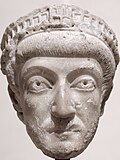Marcian
Marcian (/ˈmɑːrʃən/; Latin: [Marcianus] Error: {{Lang}}: text has italic markup (help); Greek: Μαρκιανός <span title="Lua error in package.lua at line 80: module 'Module:Language/data/ISO 639-2' not found. transliteration" class="Unicode" style="white-space:normal; text-decoration: none">Markianós; c. 392 – 26 January 457)[1] was Roman emperor in the east of the Roman Empire from 450 to 457 AD.[2]
| Marcian | |||||||||
|---|---|---|---|---|---|---|---|---|---|
 Solidus of Marcian | |||||||||
| Roman emperor in the East | |||||||||
| 25 August 450 – 26 January 457 | |||||||||
| Predecessor | Theodosius II | ||||||||
| Successor | Leo I | ||||||||
| Western emperors | Valentinian III (450–455) Petronius Maximus (455) Avitus (455–456) | ||||||||
| Born | c. 392 Thrace or Illyria | ||||||||
| Died | 26 January 457 (aged 65) Constantinople | ||||||||
| Burial | Church of the Holy Apostles, Constantinople | ||||||||
| Spouse | Pulcheria (450–453) | ||||||||
| Issue | Marcia Euphemia | ||||||||
| |||||||||
| Dynasty | Theodosian dynasty | ||||||||
| Religion | Chalcedonian Christianity | ||||||||
He was a soldier who worked for the generals Ardabur and his son Aspar for fifteen years. When the emperor Theodosius II died on 28 July 450, Marcian was made a candidate to be emperor by Aspar. Aspar had power because he controlled the Roman army.
After a month of negotiation, Pulcheria, Theodosius' sister, agreed to marry Marcian. Zeno, a man with almost as much power as Aspar, may have been part of these negotiations. Zeno got the high title of patrician after Marcian became emperor, perhaps as a reward. Marcian was inaugurated as Emperor on 25 August 450.
Marcian undid many of the acts of Theodosius II in the Romans' relations with the Huns (led by Attila) and in the organization of the Christian Church. Marcian soon broke all treaties with Attila, ending all subsidy payments to him. In 452, while Attila and the Huns were attacking the Italian Peninsula (part of the western Roman Empire), Marcian's armies attacked across the Danube river into the Great Hungarian Plain. There the Roman armies overcame the Huns in their own country. Because of this, and because of a famine and epidemic in northern Italy, the western Roman Empire was able to bribe Attila into retreating from the Italian Peninsula.
When Attila died in 453, it was the downfall of the Huns' power. Marcian improved the Romans' position by allowing Germanic peoples to live in Roman lands as allies. They did military service in exchange for this right. Marcian called together the Council of Chalcedon, which agreed that Jesus had two "natures": divine and human. This made the populations of Roman Syria and Roman Egypt Marcian's enemies. People in these places did not agree with this official Christology.
Marcian died on 26 January 457. At the end of Marcian's life, the Empire's treasury was full of money. There were seven million more gold coins than were needed, even though the cost of the wars and treaties with the Huns had been high. After Marcian died, Aspar decided against Marcian's son-in-law Anthemius being emperor. Aspar used his power to make Leo I emperor.[3]
Marcian Media
Fourth Ecumenical Council of Chalcedon, 1876 painting by Vasily Surikov
Death of Marcian, who is succeeded by Leo I (right). Scene from the 12th century Manasses Chronicle.
References
- ↑ Jones, Martindale & Morris 1980, p. 715.
- ↑ Bauer, Susan Wise 2010. The history of the medieval world: from the conversion of Constantine to the first Crusade. New York: W.W. Norton. ISBN 978-0-3930-5975-5.
- ↑ Jones, Arnold Hugh Martin; Martindale J.R.; Morris J. 1980. The Prosopography of the later Roman Empire. Volume 2, AD 395–527. Cambridge: Cambridge University Press. ISBN 978-0-521-20159-9





